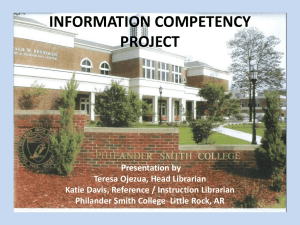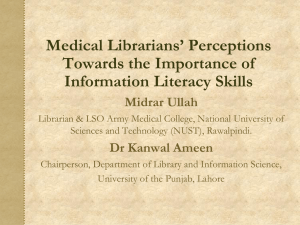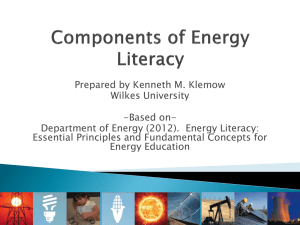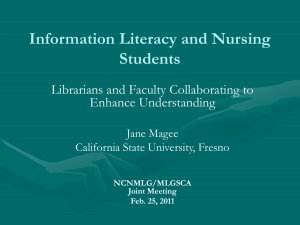View/Open - YorkSpace
advertisement
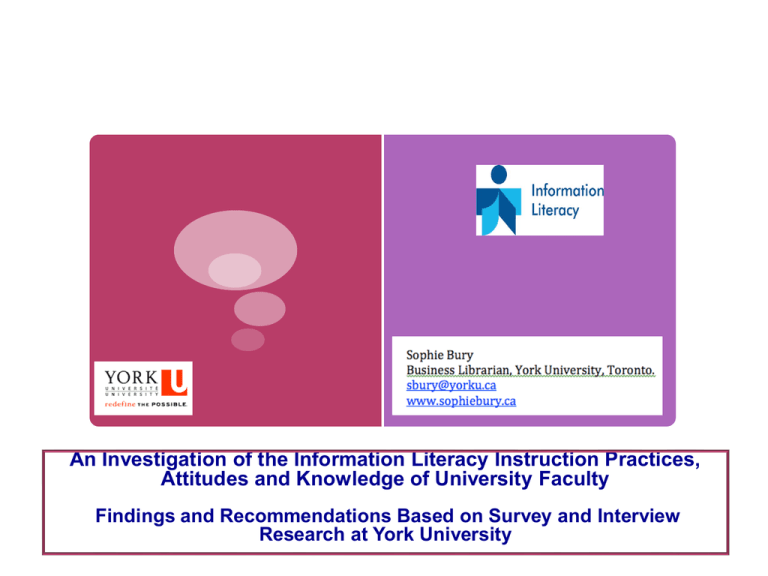
An Investigation of the Information Literacy Instruction Practices, Attitudes and Knowledge of University Faculty Findings and Recommendations Based on Survey and Interview Research at York University Background & motivation for study Much about role of faculty librarian collaboration in information literacy planning and instruction written by librarians for librarians. Literature rich in second-hand accounts of faculty behaviour. Lack of research studies exploring faculty attitudes, perceptions, behaviours and practices. (McGuinness, 2006). Existing research studies show evidence of a disconnect between faculty and librarians around teaching roles. Greater understandings of respective roles and cultures could be fostered by more research. Yet information literacy competencies, to be taught well, require substantial input from faculty. (Gullikson, 2006) York University Libraries’ Information Literacy Manifesto (2005-2010) Assessment a core strategic priority including needs assessment with faculty. Goals of learning more about: Faculty perceptions of York students’ information literacy habits, needs, and IL competency levels. Faculty perceptions of the importance of IL competencies & IL instruction among students. Existing IL practices among faculty. Faculty beliefs about ideal frameworks for IL instruction at York University. In-class or outside class. Online, in-person, blended. Optional, mandatory Methodology Web-based Survey (stage one) Primarily closed-ended questions. Comments invited and faculty quite responsive. Spring 2007. All full-time faculty at York. 221 usable responses. Data analyzed using SPSS 16.0. Cross-tabulations, chi-square testing. Statistically meaningful analysis possible at very broad disciplinary level: Sciences & Engineering (N=48) Social Sciences & Humanities (N=130) Professional Schools - Business & Law (N=39) Methodology 24 semi-structured interviews (stage two) during winter/spring 2010. One third in each of these broad areas: Business Science Social sciences and humanities Within each disciplinary area: All interviewees have expectations that students demonstrate library and information research skills. 50% of faculty arrange for IL instruction with the library. 50% of faculty organize no IL instruction with the library. All interviews recorded and transcribed. Faculty Perceptions of Students’ IL Abilities Faculty perceptions of students’ IL competencies: Different levels Faculty Ratings of Information Literacy Competencies of Students They Teach 0.6 Ranking where 1="very poor" and 7="excellent" 7 12 0 6 37.7 7.8 1.4 28.7 5 7.7 25.6 Graduate Students 15.6 4 39.4 21.7 4.2 3 1.2 2 20 5.6 0.6 1.1 1 0 3rd & 4th Year Undergraduates 1st & 2nd Year Undergraduates 24.5 30.1 14.7 10 20 30 40 % Faculty Selecting Response 50 Faculty perceptions of students’ IL competencies: Mean rankings (scale 1-7) * = differences across disciplines found to be statistically significant. 1st-2nd Year Undergrads* 3rd-4th year Undergrads* Graduate Students Across all disciplines 2.82 4.08 5.32 Sciences and Engineering 2.74 4.21 5.42 Social Sciences & Humanities 2.72 3.96 5.33 Professional Schools (Business & Law) 3.61 4.59 5.21 Faculty concerns about student IL ability (based on survey comments analysis) Heavy reliance on free web. Lack of motivation to go beyond this. Heavy reluctance to use print resources. Perceptions of their own abilities, higher than actual abilities. Failure to distinguish between online library resources and internet more generally. Skills in distinguishing between types of resources lacking. Scholarly versus popular especially. Faculty perceptions of students’ IL competencies Used as a reference point for one interview question to gauge faculty impressions of undergraduate students’ IL abilities in the context of their teaching and disciplinary areas: Determine the extent of information needed Access the needed information effectively and efficiently Evaluate information and its sources critically Incorporate selected information into one’s knowledge base Use information effectively to accomplish a specific purpose Understand the economic, legal, and social issues surrounding the use of information, and access and use information ethically and legally Source: Association of College & Research Libraries. Information Literacy Competency Standards for Higher Education. http://www.ala.org/ala/mgrps/divs/acrl/standards/informationliteracycompet ency.cfm Faculty concerns about undergraduate students’ IL competencies Getting started: Determining the nature and extent of relevant information available “They don’t know where to get started or they start in the wrong places.” (Hard Sciences) “…focusing is really one problem they have in research. They start out with these enormous topics…I mean you tell them to be as narrow as possible but then you have to really say: ‘What are you doing?’” (Humanities) “It’s just a huge challenge to get them to do anything but Google. Yeah, they think Google and they are done. Stop! Think beyond that.” (Social Sciences) “..the first [stage] was to clarify for themselves: ‘Okay, what’s my general topic?’…So working first on the logical skills of clarifying the topic, the argument. ‘What do I want to think about? What do I want to propose?’ That took a lot of time!” (Humanities) Faculty concerns about undergraduate students’ IL competencies Evaluative/Critical thinking skills “But the idea that you just go on the Internet and just find out your answers. It seems to me everyone is very comfortable with that. Not comfortable with thinking: ‘Is it true?’ Not comfortable with thinking: ‘Is this the best possible source and how do I discriminate?’” (Health Sciences) “Often these kids in one sense think of themselves as information literate because they are fairly good at finding stuff using Google but they are often not very sophisticated about evaluating information. And that’s really where the hard work is…They think that what they are looking for are facts…they think you can find a clear definite answer…that this is it and that there aren’t all these other factors, grey areas, and we really don’t know…part of growing up too is learning to live with uncertainty. But I think it’s also a school system thing…it’s all rubrics and so laid out. It’s kind of formulaic.” (Humanities) “And they all say: ‘Well, how many of these do I have to find?’ They want a number. And it’s like: ‘You need as many as you need to cover the topic you’ve chosen.’ So the idea here is evaluating the information and its sources critically. It’s not the number, it’s how good they are.” (Health Sciences) Faculty concerns about undergraduate students’ IL competencies Evaluative/Critical thinking skills “Very often Wikipedia is cited as a reference. And really that isn’t enough for what I would consider scientific literature.” (Hard Sciences) “I think that cognitive problem solving stuff is almost being circumvented a little bit because we have all this different technology stuff and that’s why we have students who come in not knowing how to process information: what’s important, what’s not important.” (Health Sciences) “They were very open to having the technology help them clarify search skills which is lovely and amazing and really scary because that may well contribute to short circuiting their own logical processes…all of this to say that some of the things that facilitate ease in one domain cost an enormous amount in others.” (Humanities) Faculty concerns about undergraduate students’ IL competencies Ability to incorporate selected information in to ones knowledge base “The process of reading articles, internalizing them, writing real hand-written notes, that process is no longer done…They’ll download the article, they will read it on the computer, they’ll cut the table out…None of it is processed. So I’m not quite sure how things are getting in to an internalized knowledge base anymore…And I think that’s the weakness.” (Health Sciences) “I mean, incorporating selected information in to ones knowledge base, I don’t think that students are taught enough to be self-critical. Like critical thinking also includes questioning your own assumptions, your own values and that’s something that I don’t think sort of comes naturally to a lot of the students.” (Business) Faculty concerns about undergraduate students’ IL competencies Academic integrity/Plagiarism. “One of the things I find is that skill with citation is diagnostic for me; like if people know how to cite online stuff, they have much better skills. That’s one thing I’ve noticed. It’s cut and dried… In a lot of cases people don’t even have that rudimentary level of skill.” (Business) “We are using Turnitin for the first time…I am going to have them see against their peers has anyone copied the same thing just to try and raise awareness in first year students…But we still have second year students who are unsure and will do things like, they will write a literature review and everything is in quotes. If you highlight the things in quotes, there is nothing left that’s theirs, and of course that gets a bad mark as well.” (Health Sciences) “I mean obviously these days with the Internet these kids are used to just, you know, to just downloading pirated movies and all this stuff. I mean, the other thing is that the lines are blurring…I mean, what could I or what could I not use in a lecture?” (Humanities) Faculty Views on the Importance of Information Literacy Faculty overwhelmingly recognise the value of fostering IL competencies among students York University study establishes this. Can students in your discipline benefit from receiving information literacy instruction? No 2.3% Don't Know 4.1% Repeated Finding in Other Studies Cannon (1994) Leckie & Fullerton (1999) McNamara-Morrison (2007) Webber, Boon & Johnston (2005) Yes 93.6% Faculty perceptions of the importance of individual IL competencies Mean,Median Rankings on scale of 1-7, with 7 indicating highest level of importance, and 1 indicating the lowest Capable of defining a research topic effectively Able to identify information appropriate to a given research question Understand how information is communicated in the primary discipline which they are studying Understand the differences between scholarly and popular sources Able to distinguish between primary and secondary sources of information Able to identify appropriate search tools (e.g. databases, online research tools) to find needed information Capable of formulating effective search strategies when looking for needed information within online research tools Understand how to critically evaluate library information sources found Understand how to critically evaluate information found on the free web Able to effectively synthesize information gathered from different sources Understand issues relating to academic integrity Capable of citing information sources correctly 6.35, 7 6, 6 6.37, 7 6.58, 7 6.45, 7 6.21, 6 6.21, 6 6.51, 7 6.64, 7 6.49, 7 6.6, 7 6.27, 7 Faculty perceptions of the importance of individual IL competencies Weetman (2005) reports that a vast majority of faculty (ranging from 85% to 97%) say each skill as defined by SCONUL “seven pillars” is essential by the end of the course. Gullikson (2006) found 61 out of 87 of ACRL IL Standards for Higher Education given ranking of 3.25/4 or higher. Both this study and Gullikson (2006) Highest ranked competencies fall within ACRL IL standards three, four and five. Lowest ranked competencies fall within ACRL IL standard two. Faculty perceptions of the importance of individual IL competencies “I mean I could see [IL] as fundamentally enhancing a student’s effectiveness in every other course they take which would be a really good argument for having it as part of the core curriculum with an academic mandate rather than a library mandate.” (Business) “…I think we’d like to have undergraduate students graduating with an ability to discern what is useful information, how to use it effectively, and how to bring it in to their knowledge base. That’s just a life experience thing.” (Health Sciences) “I always try to point out to them that these are, in a sense, life skills – that they are consumers of information throughout their lives, and that they might as well be savvy consumers…” (Humanities) IL Instruction: Faculty Beliefs vs. Practices Appropriate Roles & Information Literacy Instruction: What Faculty Think York Study Should be a collaborative endeavour between librarians and faculty: 78.7% - faculty and librarians together. 10% - librarians only. 7.1% - faculty only. 4.3% - either faculty or librarians. Other Studies – Mixed findings: Substantial support for collaborative model – Cannon (1994), Gonzales (2001), Leckie & Fullerton (1999). Faculty feel little or no responsibility for teaching information literacy – Thomas (1994), McGuinness (2006) Appropriate Roles & Information Literacy Instruction: What Faculty Do York University: Disconnect between belief and practice. Corroborated by findings of other studies Note, however, statistical significance of gender as demographic variable: female faculty found to incorporate IL Instruction more than male faculty. Manuel, Beck & Molloy (2005) in a review of the LIS literature conclude that: Are information literacy competencies taught to students as part of your courses? 120 “various studies report that 55 to 85% of the faculty do not use librarian-provided instruction” 100 80 37.5 47.1 60.4 68.8 60 No % 40 Yes % 62.5 52.9 20 39.6 31.3 0 All Science & Engineering Social Sciences & Humanties Professional Schools (Business & Law) Only Thomas (1994) found gender to be significant – female faculty 2.5 times more likely to introduce instruction than male faculty. Who is doing the teaching? Almost 55% of York University faculty, who are incorporating information literacy instruction, are doing this themselves. Studies by Gonzales (2001), Cannon (1994), and Leckie & Fullerton (1999) and McGuinness (2006) reveal similar findings. 11.3 Teach myself (%) 34.8 53.9 Faculty and librarian coteach(%) Librarian teaches (%) Faculty/librarian roles and information literacy instruction Faculty who organize IL with the library define the value of the librarian role in a range of ways: “…the nice thing about a librarian coming in to the 2030 class is the fact that it is just one more voice telling them. And it’s a slightly different perspective.” (Health Sciences) “[my subject librarian] was very good to underscore that librarians are not just the sort of people who reshelve books librarians are scholars…So it would be nice if students thought about librarians in terms of research just like they think of their professors…We can help that by bringing librarians in to the place where students value their professors...For whatever reason they don’t value them as much in the library. They see you more as service providers.” (Humanities) “Yes. It’s recursive. Just because you went to the library workshop and hit all the nails on the head, it doesn’t mean the students walk out knowing it. You have to design the course so they can practice it.” (Social Sciences) Faculty/librarian roles and information literacy instruction Faculty who organize IL with the library define the value of the librarian role in a range of ways: “Access to needed information: that’s what I am hoping I guess the library introduces them to.” (Hard Sciences) “Librarians are spending an awful lot of time doing workshops but I think if I were strategic planning with the library, I would put 20% of my librarian teaching time in to teaching and the rest working with departments to assist with integrating IL in to their curriculum…I think that synergy between the library and curriculum planning is crucial…” (Social Sciences) “…ideally they cooperate…[this] needs to happen a lot more…But it’s also important because…people are isolated in their little own holes…and we can either work at cross purposes or we can work together…it again sends the message to students that in a sense, what should I say, that knowledge isn’t a bunch of subject specialists in little holes, but that actually there is the problem of integrating it and that’s the final cask in a way.” (Humanities) The non-adopters: Why some faculty offer no IL instruction 47.1% of York faculty are not incorporating IL instruction. Reasons given: Curriculum too full and not enough time (61.1%) Leckie & Fullerton (1999) & Cannon (1994) = approx 25%, while Thomas (1994) = 53.9% Lack of awareness (18.8%) Larger factor in most other studies: Cannon (1994)= 40%; Gonzales (2001)=46%, Leckie & Fullerton (1999)= 31%. Other reasons included: Not faculty’s responsibility (22.2%). Students can teach themselves these competencies(22.2%). Students have these competencies already (13.3%) Faculty beliefs about ideal frameworks for IL instruction at York University. Should Information Literacy Instruction be Mandatory or Optional? 120 100 14.3 18.3 16.2 27.7 80 60 Optional % Mandatory % 40 81.7 85.7 83.8 Social Sciences & Humanties Professional Schools (Business & Law) 72.3 20 0 All Science & Engineering Faculty beliefs about ideal frameworks for IL instruction at York University. Optional or required? 25 faculty comments received: 15 out of 25 express unwaivering support for mandating this type of instruction somewhere, with only four expressing reservations. Five faculty show support with qualifications. Provide it only where students shown to need it. Illustrative comment: “The competency itself should be mandatory, Whether the instruction should be depends on competency the students have already achieved.” Faculty beliefs about ideal frameworks for IL instruction at York University. Optimal IL Delivery Mechanisms Disconnect between what is done, and what faculty believe should happen: In practice, most faculty adopting IL instruction within class time (79% during lectures, 36% during tutorial time, 12% outside class) Optimally 39% of faculty believe IL instruction should take place outside scheduled class time, and only 45% think it should happen during class time. Thomas (1994) and McGuinness (2006) find similar strong believe in NIMBY (not-in-my-backyard) approach. Faculty beliefs about ideal frameworks for IL instruction at York University. Optimal IL Delivery Mechanisms In-class, outside class, or online? 63 faculty comments received. Asked to comment on in-class, outside class, or online Integration during class time at some point in a program desirable (33 comments) Multi-method approach optimal (31 comments) Assignments or task-specific objectives essential to ensure learning (7 comments) Reservations about in-class delivery due to lack of time (9 comments) Faculty beliefs about optimal delivery frameworks: IL instruction inside class or outside class? Faculty who organize IL predominantly favour an in-class approach, though recommended models vary: “We should as a program…have thought through what you should be able to do by the end of 1st year, 2nd year. It should get progressively more challenging and difficult. We should give them lots of practise and we should be assessing them as they go.” (Social Sciences) “We’ve got to make decisions at the program level as to how we do this sort of thing…perhaps part of orientation. We also need to do it some time in between, when we identify people who are falling behind. So there are various ways in which we could do it in a more structured manner. I find doing it course by course works especially at lower levels but at upper levels, they are saying, half of them, they’ve seen [the librarian] before.” (Business) Faculty beliefs about optimal delivery frameworks: IL instruction inside class or outside class? Faculty who organize IL predominantly favour an in-class approach, though recommended models vary: “I think the simple answer could be as easy as let’s dedicate a one credit course at the first year level and second year level and third year level and fourth year level…one credit is usually one hour a week…utilized in the development of you know information skills, information gathering skills, writing skills.” (Hard Sciences) “If this was an elective, like if it’s an elective, people will not mind. If you want it in the core, it’ll be an issue because something else will have to go and that’s really the obstacle…” (Business) Faculty beliefs re optimal delivery frameworks: IL instruction best delivered online, in-person, or as blended model? Faculty who organize IL with the library generally see blended model as the preferred approach: “It’s my view modern education is best delivered both online and in the classroom…Is there a need, a niche for purely online courses? Yes. Is there a niche for purely classroom delivered courses? Yes. But is there a role where the strengths of those two styles combine and you get a better product? Absolutely.” (Hard Sciences) “I am using Moodle as a way for them to give each other feedback. It is fostering cooperative stuff.” (Social Sciences) “Everyone in the working group thought there had to be much more blended learning, lots more using technology…technology can be used to promote deeper learning and more durable learning and it’s just not being used by any means even to promote deep learning right now.” (Business) Conclusions Implications for Practice: Flexible approach to IL models and approaches desirable as faculty preferences vary. Case for investigating further the role and place of faculty development in an IL program. Need for stronger library advocacy role. Though awareness of IL instruction is high (84% survey respondents), 57% say a better job of promoting IL could be done. Implications for Research: More research to gain deeper understanding of why faculty choose not to adopt IL instruction. More research to obtain more in-depth understanding of faculty views on models of information literacy instruction which are most effective or desirable. Bibliography Anita Cannon, “Faculty Survey on Library Research Instruction,” RQ 33, no. 4 (1994): 524-41. R. Gonzales, “Opinions and Experiences of University Faculty Regarding Library Research Instruction: Results of a Web Based Survey at the University of Southern Colorado,” Research Strategies (April 18, 2001): 191-201. Shelley Gullikson, “Faculty Perceptions of ACRL's Information Literacy Competency Standards for Higher Education,” The Journal of Academic Librarianship 32, no. 6 (November 2006): 583-592. L. Hardesty, “Faculty Culture and Bibliographic Instruction: An Exploratory Analysis,” Library Trends 44, no. 2 (1995): 339-67 Gloria J. Leckie and Anne Fullerton, “Information Literacy in Science and Engineering Undergraduate Education,” College and Research Libraries 60, no. 1 (January 1999): 9-29. Claire McGuinness, “What Faculty Think-Exploring the Barriers to Information Literacy Development in Undergraduate Education,” The Journal of Academic Librarianship 32, no. 6 (November 2006): 573-582. Laurie McNamara Morrison, “Faculty Motivations: An Exploratory Study of Motivational Factors of Faculty to Assist with Students' Research Skills Development,” Partnership: The Canadian Journal of Library and Information Practice and Research 2, no. 2 (2007). Bibliography Paul O. Jenkins. Faculty-Librarian Relationships. (Oxford: Chandos Publishing, 2005). Kate Manuel, Susan E. Beck, and Molly Molloy, “An Ethnographic Study of Attitudes Influencing Faculty Collaboration in Library Instruction,” The Reference Librarian 43, no. 89 (2005): 139-60. Annmarie B Singh, “A Report on Faculty Perceptions of Students' Information Literacy Competencies in Journalism and Mass Communication Programs: The ACEJMC Survey,” College & Research Libraries 66, no.4 (July 2005): 294-310. J. Thomas, “Faculty Attitudes and Habits Concerning Library Instruction: How Much Has Changed Since 1982?,” Research Strategies (1994):209:223. S. Webber, S. Boon, and B. Johnston. “A Comparison of UK Academics' Conceptions of Information Literacy in Two Disciplines: English and Marketing.” Library and Information Research News 29, no. 2005 (2005): 4-15. . Jacqui Weetman, “Osmosis - Does It Work for the Development of Information Literacy?,” Journal of Academic Librarianship 31, no. 5 (September 2005): 456-460.
